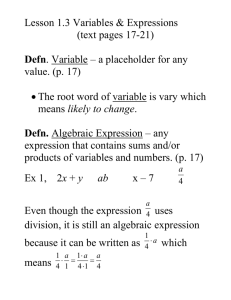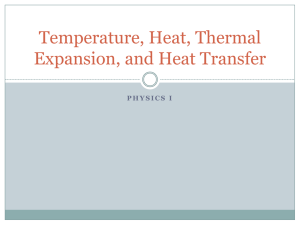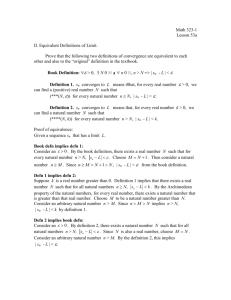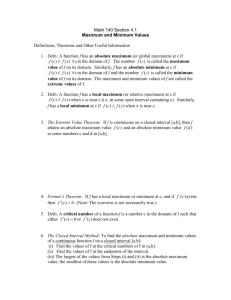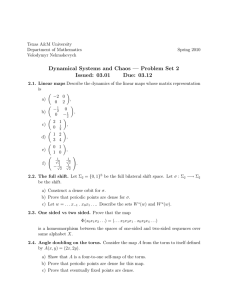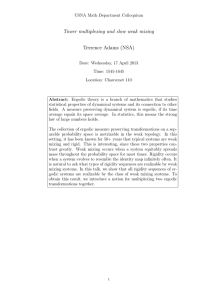Lecture 21: Set time to finish HW1: Thursday at 5:30?
advertisement
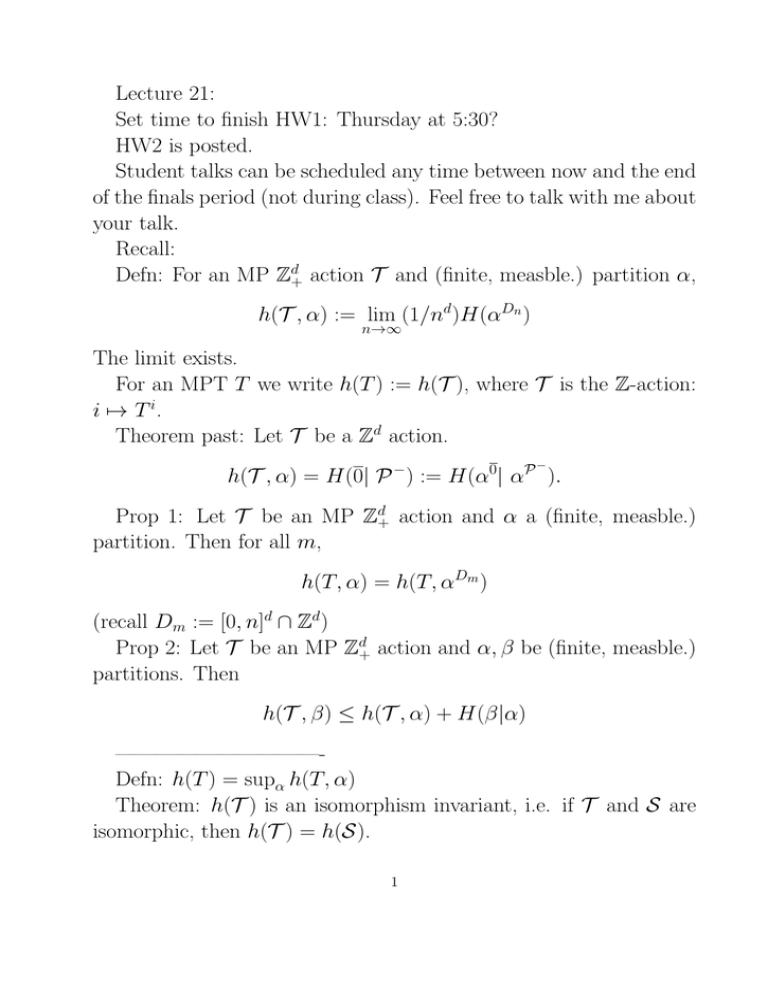
Lecture 21:
Set time to finish HW1: Thursday at 5:30?
HW2 is posted.
Student talks can be scheduled any time between now and the end
of the finals period (not during class). Feel free to talk with me about
your talk.
Recall:
Defn: For an MP Zd+ action T and (finite, measble.) partition α,
h(T , α) := lim (1/nd)H(αDn )
n→∞
The limit exists.
For an MPT T we write h(T ) := h(T ), where T is the Z-action:
i 7→ T i.
Theorem past: Let T be a Zd action.
−
h(T , α) = H(0| P −) := H(α0| αP ).
Prop 1: Let T be an MP Zd+ action and α a (finite, measble.)
partition. Then for all m,
h(T, α) = h(T, αDm )
(recall Dm := [0, n]d ∩ Zd)
Prop 2: Let T be an MP Zd+ action and α, β be (finite, measble.)
partitions. Then
h(T , β) ≤ h(T , α) + H(β|α)
——————————Defn: h(T ) = supα h(T, α)
Theorem: h(T ) is an isomorphism invariant, i.e. if T and S are
isomorphic, then h(T ) = h(S).
1
Proof: An isomorphism φ : M → N sets up a bijection between
finite measble. partitions α of M (the space T acts on) and finite
measble. partitions β of N (the space S acts on): So
h(T ) = sup h(T , α) = sup h(S, φ(α)) = sup h(S, β) = h(S)
α
α
β
How to compute h(T )?
Defn: A one-sided generator for an MP Zd+ action T on (M, A, µ)
is a (finite, measble.) partition α such that
d
αZ+ = A
One-sided generator theorem (d = 1: Sinai): Let α be a one-sided
generator for an MP Zd+ action. Then
h(T ) = h(T , α)
(and so we have some hope of computing h(T )).
Proof: It is equivalent to show that for any (finite, measble.) partition β, we have h(T , β) ≤ h(T , α).
By Prop 2 applied to αDm and then Prop 1,
h(T , β) ≤ h(T, αDm ) + H(β|αDm ) = h(T, α) + H(β|αDm )
But since αDm ↑ A, by continuity of conditional entropy, as m → ∞,
H(β|αDm ) → H(β|A)
Since β ⊂ A, we have, H(β|A) = 0 (Entropy property 3). Thus,
h(T, β) ≤ h(T, α). Defn: A two-sided generator for an MP Zd action T on (M, A, µ)
is a (finite, measble.) partition α such that
d
αZ = A
2
Two-sided generator theorem (d = 1: Sinai): Let α be a 2-sided
generator for a MP Zd action T . Then
h(T ) = h(T , α)
Proof (exercise):
Modify proof of Prop 1 to show that for Zd actions h(T, α) =
h(T, αBm ).
Modify proof of previous Theorem by replacing Dm by Bm. Example: stationary random field Xi : i ∈ Zd+ or Zd.
d
– shift action T+ on F Z+ , let α+, the one-sided “time 0 cylinder
partition,”
—- α+ is a one-sided generator
—- h(T+) = h(T+, α+)
d
– shift action T on F Z , α, the two-sided “time 0 cylinder partition,”
—- α is a two-sided generator.
—- h(T ) = h(T , α)
So, h(T ) = h(T+) = limn→∞(1/nd)H(pn) where pn is the joint
distribution of the random variables corresponding to the cube Dn.
In particular, if the stationary random field is iid (p), then h(T ) =
h(T+) = h(p).
So, the actions (Zd+ or Zd) corresponding to iid p = (1/2, 1/2) and
iid q = (1/3, 1/3, 1/3) are not isomorphic. This solved a major open
problem in ergodic theory and injected new life into the subject.
And h( doubling map ) = h( Baker’s transformation ) = log 2.
Example: For (d = 1) stationary Markov with transition matrix
P with stationary vector π:
X
h(T ) = −
πipij log pij
ij
3
Proof:
−
h(T ) = h(T, α) = H(α|αP ) = H(α0|α−1∨(∨i≥2α−i)) = H(α0|α−1)
by Two-sided generator theorem, Theorem past, and Entropy property 10: H(α|B ∨ C)) ≤ H(α|B) with equality iff α ⊥B C (the
Markov property).
Finally, by definition,
X
0 −1
πipij log pij ,
H(α |α ) = −
ij
Ornstein Isomorphism Theorem (1968): For d = 1 mixing Markov
chains (in particular iid), entropy is a complete invariant of isomorphism.
Example: H((1/4, 1/4, 1/4, 1/4)) = log 4 = H(1/2, 1/8, 1/8, 1/8, 1/8)
Example: (d = 2) h( Ledrappier 3-dot ) = 0.
Proof: Every configuration on Dn is uniquely determined by a
configuration on {[0, 2n] × {0}
Let α be the time-0 partition. Then
H(αDn ) ≤ log |(αDn | = log 24n
Thus,
h(T ) = h(T , α) ≤ lim (1/n2) log 22n = 0.
n→∞
4
Lecture 22:
Recall:
d=1
h( doubling map ) = log 2 because it is isomorphic to the onesided iid (1/2,1/2) shift map. There is a one-sided generator α s.t.
|αn| ∼ 2n.
Exercise: h( rotation of circle) = 0 because:
– rational case, it looks like the identity.
– irrational case, it has a one-sided generator α s.t. |αn| ∼ 2n
Existence of generators: one-sided generator is stronger than a
two-sided generator, and the latter makes sense only for Zd actions,
as opposed to Zd+ actions; for d = 1, this means IMPT’s, as opposed
to MPT’s.
– If T is an ergodic IMPT with h(T ) < ∞, then T has a two-sided
generator (Krieger)
Topological Dynamics:
Defn: A topological dynamical system (TDS) is a continuous map
on a compact metric space T : M → M .
Defn: An invertible top dyn sys (ITDS) is a homeomorphism
T : M → M (equivalently, a bijective continuous map, since M is
compact).
Iterate T , just as in ergodic theory.
More generally:
Defn: For a compact metric space M , Cts(M ) denotes the set
of continuous T : M → M and Homeo(M ) denotes the set of
homeomorphisms of M .
Defn: A continuous group action (Cts) of a group G on a compact
metric space M , is a group homomorphism G → Homeo(M ):
5
– g 7→ T g satisfying T g1g2 = T g1 ◦ T g2
Similarly, a continuous semi-group action (Cts) is a semi-group
homo: G → Cts(M ):
We are interested in the group Zd and semi-group Zd+:
G = Zd: generated by d commuting ITDS.
G = Zd+: generated by d commuting TDS.
Defn: Orbit of x ∈ M is {T i(x) : i ∈ G}
Note: to avoid confusion, when G = Zd, we will distinguish between the Zd-orbit, {T i(x) : i ∈ Zd} and the Zd+-orbit, {T i(x) : i ∈
Zd+}
Analogue of ergodicity:
Defn: A Cts Zd+ action T = (i 7→ T i) is topologically Transitive
if for all nonempty open sets A, B, there exists n ∈ Zd+ s.t. T −n(A)∩
B 6= ∅.
Prop: Let T be a Cts Zd+ action. Then T is top. transitive iff the
set of points with a dense orbit is a dense Gδ .
Proof: Let {Am} be a basis for topology of M . Let
Gm := ∪i∈Zd T −i(Am)
+
Let
D := ∩∞
m=1 Gm
Claim: x ∈ D iff x has a dense orbit.
Proof: x ∈ D iff ∀m ∃i ∈ Zd+ s.t. T i(x) ∈ Am.
Replace ∀m ∀ open sets U and replace Am with U . If T is topologically transitive, then for every nonempty open set
B, Gm ∩ B 6= ∅. Then Gm is a dense open set. By Baire Category
Theorem), D is a dense Gδ .
6
Conversely, if D is dense, then there exists a point x ∈ B with
a dense orbit. But then T i(x) ∈ A for some i ∈ Zd+. So, x ∈
T −i(A) ∩ B. Note: if T is a surjective TDS, then it can be shown that it is also
equivalent to just have some point with a dense orbit.
Note: it is also equivalent to replace n ∈ Zd+ with n ∈ Zd+ \ {0}
in the defn. or top. trans.
Analogue of mixing:
Defn: A Cts Zd+ action T = (i 7→ T i) is topologically mixing
if for all nonempty open set A, B, there exists N > 0 s.t. for all
n ∈ Zd+ with |n| ≥ N , T −n(A) ∩ B 6= ∅.
Note: in analogy with a generating semi-algebra for a probability
space, it suffices to check Top. transitivity and Top. mixing only on
a basis for the topology of M .
Note: Top mixing implies Top transitive.
Defn: For a Cts Zd+ action T , M(T ) is the set of all T -invariant
Borel probability measures µ, i.e. for all Borel A ⊆ M and i ∈ Zd+,
µ(T −i(A) = µ(A).
So, for µ ∈ M(T ), T is an MP Zd+ action on (M, A, mu).
Note: If T is a Cts Zd action, µ ∈ M(T ), and i ∈ Zd, then
µ(T i(A) = µ(A) because for instance: µ(A) = µ(T −e1 T e1 (A)) =
µ(T e1 (A)).
Defn: For a Borel probability measure µ on a compact metric
space M , the topological support supp(µ) is the smallest closed set
of measure one, equivalently, the complement of the union of all open
sets of measure zero.
Defn: µ is fully supported if supp(µ) = M , equivalently µ is
strictly positive on all open sets.
7
Prop: Let T be a Cts Zd+ action. Suppose µ ∈ M(T ) is fully
supported.
— If T is ergodic wrt µ, then T is Top. Transitive.
— If T is mixing wrt µ, then T is Top. Mixing.
8
Lecture 23:
No office hours today.
Recall Defns of TDS, ITDS, Cts Zd+ action, Cts Zd action.
Defns. of Top. Trans. and Top. Mixing.
Top Mixing implies Top Trans.
Defn of M(T ).
For µ ∈ M(T ) fully supported, ergodicity (resp. mixing) w.r.t.
µ implies Top Trans (resp., Top Mixing).
———————Defn: For a TDS T , x ∈ M is periodic if for some n > 0,
n
T (x) = x;
— this means that the orbit of x is {x, T x, . . . , T n−1(x)}; x is a
fixed point if T (x) = x.
Can also define notion of periodic point for a Cts Zd+ action.
————–
Skip:
For a Cts Zd+ action T , x ∈ M is periodic if for some n ∈ Zd+\}0},
T n(x) = x;
x is fully periodic if for some linearly independent set S ⊂ Zd+, ∀n ∈
S, T n(x) = x.
– for Zd action, fully periodic means that the Zd-orbit is finite.
——————
Examples:
1. circle rotation: z 7→ az, a = eir , r ∈ [0, 2π)
—– r/(2π) ∈ Q: all points are periodic; not top. trans.; therefore,
not top, mixing
—– r/(2π) 6∈ Q: all orbits are dense; no periodic points; top.
trans., since ergodic w.r.t Lebesgue; not top. mixing
9
2. doubling map on circle: z 7→ z 2 (eiθ 7→ e2iθ ).
this is similar to the doubling map on [0, 1]: x 7→ 2x mod 1,
but rescaled and made continuous.
top. trans. and top. mixing, since the doubling map on [0, 1]
is mixing w.r.t. Lebesgue
will see that it has a dense set of periodic points.
This gives a rich mixture of periodic and “ergodic” behaviour.
3. Example: Full two-sided Shift
d
Let F be a finite set. Let M = F Z . Let T = σ, the shift action.
Metric: d(x, y) = 2−k where k is maximal such that
xBk = yBk
—- if x = y, set d(x, y) = 0; if x0 6= y0, set d(x, y) = 2; this is a
metric.
—- Meaning of metric: d(x, y) is small iff x, y agree in a large
central block.
— the topology of this metric is the topology generated by cylinder
sets.
Top, mixing because for cylinder sets A, B, σ −n(A) ∩ B 6= ∅ for
suff. large n.
Thus, also top. transitive.
d = 1: Periodic points are dense: Given x ∈ M , define y =
((x−N . . . xN )∞. Then y is periodic and d(x, y) ≤ 2−N ,
This gives rich dynamics: a dense Gδ set of points with dense
orbits and a dense set of periodic points.
Example 3’: Full one-sided shift, a Cts Zd+ action
Example 4: Smale horseshoe (a continuous analogue of Baker’s
transformation):
10
T : M → M , where M is union of square V and left and right
caps A and B: AV B.
— T contracts A into itself;
— T maps B into A;
— T maps V into M by compressing in the vertical, stretching in
the horizontal and folding over.
T is 1-1 but not onto. However, it can be extended to a homeomorphism of R2 or S 2 (with a fixed point at ∞).
Dynamics:
T |L is a contraction mapping and so T has a fixed point p in L.
Let Ω := ∩n∈ZT n(V ).
Claim: If x 6∈ Ω, then limn→∞ T n(x) = p.
Proof:
If x 6∈ Ω, then for some m ∈ Z,
T m(x) ∈ A∪B, and so T m+1(x) ∈ A and so T m+n → p, as n → ∞.
Will see that T |Ω is top. mixing, therefore also top. trans., and
has a dense set of periodic points.
11
